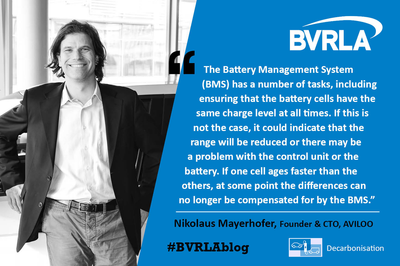Nikolaus Mayerhofer, Founder and CTO of AVILOO looks at efficient battery evaluation for electric vehicles and plug-in hybrids through diagnostics.

The Battery Management System (BMS) has a number of tasks, including ensuring that the battery cells have the same charge level at all times. If this is not the case, it could indicate that the range will be reduced or there may be a problem with the control unit or the battery. If one cell ages faster than the others, at some point the differences can no longer be compensated for by the BMS. Reduced range or lower charging power are the first signs that something is wrong with the battery. And what other signs are there?
Clear evidence of a cell defect
There are three ways to detect cell or battery defects:
- Spread in the cell voltages: Depending on the temperature, state of charge and State of Health (SoH) of the battery, abnormalities can be detected in the battery or the BMS based on the spread of the cell voltages.
- SoH deviations:
- Low SoH: Even a noticeably strong SoH loss can be a sign of a cell defect (e.g. lithium plating). Battery cells whose health status is too far below the manufacturer's specifications (e.g. manufacturer guarantees 70%, but SoH is below 60%) can pose a danger to driving, especially if the SoH does not correspond to the age or mileage of the vehicle.
- SoH spread: If the condition of the cells differs significantly, this can indicate manufacturing defects in new vehicles. In older vehicles, this leads to an unbalanced load on the cells and thus to an increased risk of overloading the aged cells.
- Internal resistance deviations:
- Increased internal resistance: Depending on the temperature, state of charge and of the battery, cell defects can be located by determining the cell's internal resistance.
- Spread in internal resistance: When the cells age optimally, they age evenly in terms of loss of capacity and increase in internal resistance. If a significantly greater increase in resistance can be detected in individual cells, this is a sign of manufacturing defects.
But cell defects that cannot be detected with electrical signals can also occur. These can only be identified in a laboratory by splitting the cell and analysing it under a microscope.
What should you do now?
Inspect the battery to rule out a variety of anomalies within the cell pack.
AVILOO FLASH Test, enables rapid screening of numerous vehicles within a short time frame. In just three minutes, the test provides an analysis of the battery condition and presents the results in the form of numerical values in an independent report. The FLASH test can detect battery faults down to the cell level, which is invaluable for marketing a used car and providing transparency during resale. The test provides a comprehensive analysis of the functionality of the battery without moving the vehicle. This is ideal for testing lease returns.
To thoroughly examine the battery, carry out a test, such as AVILOO PREMIUM Battery Test that enables a more comprehensive battery analysis because the battery is measured in detail over a longer period. This means that significantly more data is available. During the PREMIUM test, the dynamics are used to analyse the internal resistance down to the cell level. This test has TÜV certification.
Analysis down to the cell level is crucial for battery diagnostics, as overall performance largely depends on the weakest link in the chain. A low level in an individual cell results in lower overall battery performance.
Whether choosing the quick test that takes only three minutes but can still provide a comprehensive analysis of the functionality of the battery or one that analyses the exact SoH as a percentage compared to new condition and presents this on a Certficiate, visit AVILOO Shop to order a test.
Information about State of Health (SoH) status for EV batteries.
The difference between a battery test using a detailed measurement and reading the battery is explained: SoH Readout is NOT a Battery Test.




